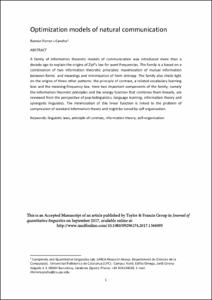Mostra el registre d'ítem simple
Optimization models of natural communication
| dc.contributor.author | Ferrer Cancho, Ramon |
| dc.contributor.other | Universitat Politècnica de Catalunya. Departament de Ciències de la Computació |
| dc.date.accessioned | 2018-07-12T10:24:52Z |
| dc.date.available | 2019-03-06T01:30:39Z |
| dc.date.issued | 2018-07-03 |
| dc.identifier.citation | Ferrer-i-Cancho, R. Optimization models of natural communication. "Journal of quantitative linguistics", 3 Juliol 2018, vol. 25, núm. 3, p. 207-237. |
| dc.identifier.issn | 0929-6174 |
| dc.identifier.other | https://arxiv.org/abs/1412.2486 |
| dc.identifier.uri | http://hdl.handle.net/2117/119274 |
| dc.description.abstract | A family of information theoretic models of communication was introduced more than a decade ago to explain the origins of Zipf’s law for word frequencies. The family is a based on a combination of two information theoretic principles: maximization of mutual information between forms and meanings and minimization of form entropy. The family also sheds light on the origins of three other patterns: the principle of contrast; a related vocabulary learning bias; and the meaning-frequency law. Here two important components of the family, namely the information theoretic principles and the energy function that combines them linearly, are reviewed from the perspective of psycholinguistics, language learning, information theory and synergetic linguistics. The minimization of this linear function is linked to the problem of compression of standard information theory and might be tuned by self-organization. |
| dc.format.extent | 31 p. |
| dc.language.iso | eng |
| dc.subject | Àrees temàtiques de la UPC::Informàtica::Intel·ligència artificial::Llenguatge natural |
| dc.subject.lcsh | Information theory |
| dc.subject.lcsh | Computational linguistics |
| dc.subject.other | Linguistic laws |
| dc.subject.other | Principle of contrast |
| dc.subject.other | Self-organization |
| dc.title | Optimization models of natural communication |
| dc.type | Article |
| dc.subject.lemac | Informació, Teoria de la |
| dc.subject.lemac | Lingüística computacional |
| dc.contributor.group | Universitat Politècnica de Catalunya. LARCA - Laboratori d'Algorísmia Relacional, Complexitat i Aprenentatge |
| dc.identifier.doi | 10.1080/09296174.2017.1366095 |
| dc.description.peerreviewed | Peer Reviewed |
| dc.relation.publisherversion | https://www.tandfonline.com/doi/abs/10.1080/09296174.2017.1366095 |
| dc.rights.access | Open Access |
| local.identifier.drac | 23245631 |
| dc.description.version | Postprint (author's final draft) |
| dc.relation.projectid | info:eu-repo/grantAgreement/MINECO//TIN2014-57226-P/ES/APRENDIZAJE COMPUTACIONAL Y COMUNICACION/ |
| local.citation.author | Ferrer-i-Cancho, R. |
| local.citation.publicationName | Journal of quantitative linguistics |
| local.citation.volume | 25 |
| local.citation.number | 3 |
| local.citation.startingPage | 207 |
| local.citation.endingPage | 237 |
Fitxers d'aquest items
Aquest ítem apareix a les col·leccions següents
-
Articles de revista [134]
-
Articles de revista [1.049]


